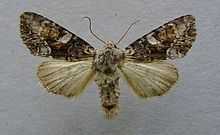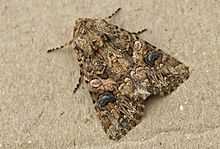Lacanobia contigua
| Lacanobia contigua | |
|---|---|
 | |
 | |
| Scientific classification | |
| Kingdom: | Animalia |
| Phylum: | Arthropoda |
| Class: | Insecta |
| Order: | Lepidoptera |
| Family: | Noctuidae |
| Tribe: | Hadenini |
| Genus: | Lacanobia |
| Species: | L. contigua |
| Binomial name | |
| Lacanobia contigua Denis & Schiffermüller, 1775 | |
The Beautiful Brocade (Lacanobia contigua) is a moth of the Noctuidae family. It is found throughout temperate regions of the Palearctic ecozone from Ireland East to Siberia and Japan.
Technical Description and variation
- See glossary for terms used
The wingspan is 36–42 mm.Forewing pale ashgrey, suffused with olive brown ; a black streak from base below cell, with a pale costal blotch above it ; claviform stigma dark, followed by an ochreous white patch at base of vein 2; orbicular stigma whitish, with grey centre, forming with the pale patch beyond claviform and a large pale blotch on inner, margin beyond outer line a kind of oblique pale bar; reniform with lower lobe blackish, followed by a fulvous tinge; submarginal line strongly dentate, the teeth on 3 and 4 reaching margin; hindwing whitish grey, the veins and termen darker. The form subcontigua Ev. is a dark suffused insect, without the pale patches, from the Ural Mts. in Russia, but similar examples occur in other parts; - ab. amurensis Spul. from Amurland is more delicate in the outline of wing, reddish grey in colour, with the markings less distinct. [1]
Biology
The moth flies from May to July depending on the location.
Larva dull yellowish green, mottled with orange and reddish brown; dorsum with a row of dark V-shaped markings; spiracular line reddish brown.The larva mainly feed on a wide variety of various trees, bushes and herbaceous plants:Betulaceae, Umbelliferae, Ranunculaceae Cruciferae, Salicaceae,Dennstaedtiaceae, Crassulaceae, Urticaceae, Ericaceae etc. .[2]
References
- ↑ Seitz, A. Ed., 1914 Die Großschmetterlinge der Erde, Verlag Alfred Kernen, Stuttgart Band 3: Abt. 1, Die Großschmetterlinge des palaearktischen Faunengebietes, Die palaearktischen eulenartigen Nachtfalter, 1914
- ↑ "Robinson, G. S., P. R. Ackery, I. J. Kitching, G. W. Beccaloni & L. M. Hernández, 2010. HOSTS - A Database of the World's Lepidopteran Hostplants. Natural History Museum, London.".
External links
| Wikimedia Commons has media related to Lacanobia contigua. |